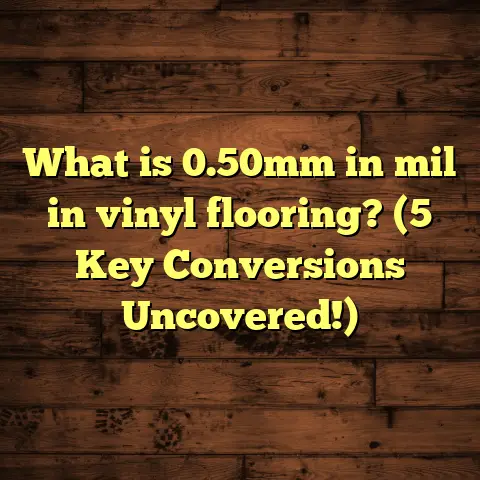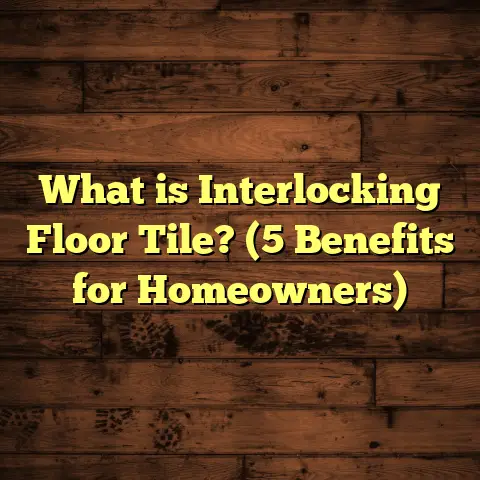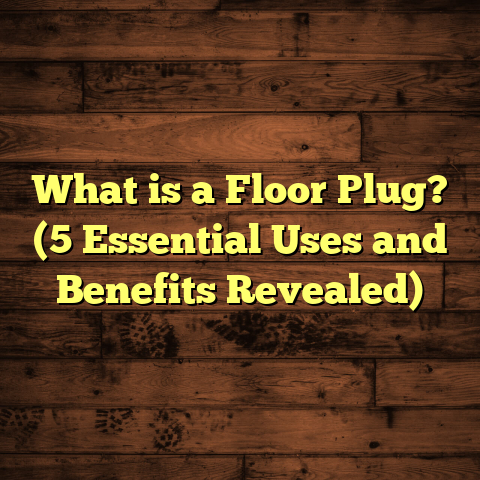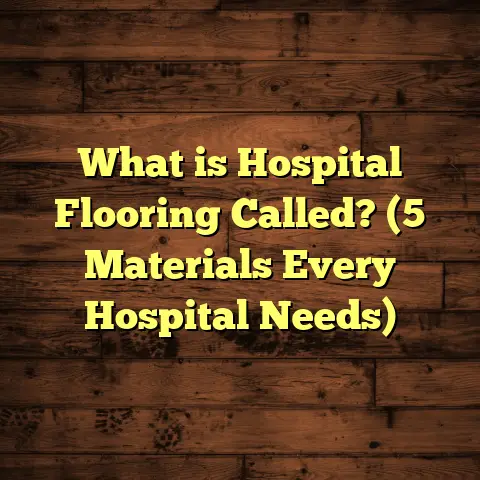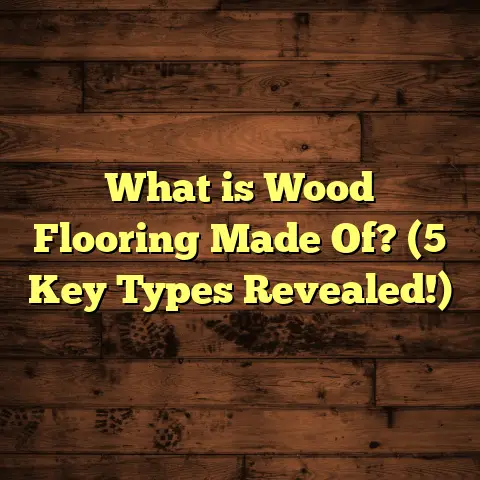What is Fake Hardwood Waterproof Scratchproof Floor? (5 Key Materials Explained)
Durability is something I always pay close attention to when selecting flooring materials. After all, a floor isn’t just a surface you walk on; it’s a part of your home that faces daily wear and tear, spills, scratches, and sometimes even water damage. Over the years, I’ve worked extensively with various flooring options, and one category that has gained massive popularity is the “fake hardwood waterproof scratchproof floor.” If you’ve ever wondered what exactly that means, how it works, and whether it’s a good fit for your home, I’m here to share everything I’ve learned.
What Is Fake Hardwood Waterproof Scratchproof Floor?
When I say “fake hardwood waterproof scratchproof floor,” I’m talking about flooring materials designed to replicate the look of real hardwood but made from different composites or synthetic materials that offer enhanced durability. These floors are manufactured to resist scratches and withstand water exposure far better than natural wood. This makes them extremely popular in homes with kids, pets, or high moisture areas like kitchens and bathrooms.
People often ask me: “Isn’t hardwood supposed to be strong enough?” The truth is, while genuine hardwood floors are beautiful and add value to a home, they do have limitations. Traditional hardwood can dent, scratch easily, and is vulnerable to water damage if not sealed properly. That’s where these engineered options come in—they combine the classic appeal of wood with technology that boosts their resilience.
In simple terms:
- Fake Hardwood means it looks like wood but isn’t solid wood.
- Waterproof means it can handle spills, humidity, and even direct water contact without warping.
- Scratchproof means it’s tough enough to resist marks from furniture, pets’ claws, or dropped items.
Now let me break down the five key materials that fall under this category and explain what makes each of them unique.
1. Luxury Vinyl Plank (LVP)
What is LVP?
Luxury Vinyl Plank has been a game changer in the flooring world. It’s a synthetic flooring product made from multiple layers of vinyl combined to create planks that look almost identical to real wood. The surface layer features high-resolution photographic prints of wood grains and textures.
Why I recommend LVP
I’ve installed LVP in several homes, especially where homeowners wanted the wood look but needed something tougher. It’s amazingly waterproof—perfect for bathrooms, kitchens, basements, or even commercial spaces. Unlike hardwood, spills don’t seep into the material. You can mop it up quickly without worrying about damage.
Installation Tips
LVP typically comes with click-lock systems that make installation straightforward for DIYers or pros. One thing I always suggest is to ensure the subfloor is clean and level—this helps avoid any bumps or gaps later.
Maintenance & Lifespan
Cleaning LVP is as easy as sweeping and occasional mopping with a mild cleaner. No need for waxing or refinishing like hardwood. A good quality LVP can last 15-20 years with proper care.
Data-backed Insight
According to recent industry reports, LVP sales have grown over 15% annually in the past five years due to its waterproof qualities and affordability compared to hardwood.
2. Laminate Flooring with Water-Resistant Core
What is Laminate?
Laminate flooring consists of a fiberboard core topped with a photographic layer that mimics hardwood designs and a protective wear layer. Newer products now come with water-resistant cores that repel moisture better than traditional laminates.
My Experience with Water-Resistant Laminate
I remember working on a home renovation where the client wanted wood look flooring but had two dogs and kids running around. We chose a water-resistant laminate that handled pet accidents without swelling or warping—a common problem with older laminates.
Installation Process
Laminate flooring is also a floating floor system, meaning it clicks together above the subfloor without nails or glue. It’s great for quick installations over concrete or plywood.
Maintenance & Durability
While laminate isn’t completely waterproof like vinyl, these newer water-resistant cores can survive occasional spills if wiped promptly. They also stand up well to scratches thanks to their hard protective coating.
Unique Insight
Laminate tends to be more affordable than vinyl and engineered hardwood but usually doesn’t last as long—expect around 10-15 years depending on traffic and care.
3. Engineered Hardwood with Waterproof Finish
Defining Engineered Hardwood
Engineered hardwood is made of a veneer layer of real wood bonded over multiple layers of plywood or fiberboard. It offers the authentic look of hardwood but with better stability due to its layered construction.
Waterproofing Aspect
Some manufacturers now apply advanced waterproof finishes or sealants making engineered hardwood more resistant to water damage than traditional solid wood floors. While not fully waterproof like vinyl, these finishes allow it to handle humidity and minor spills better.
Why I Like Engineered Hardwood for Some Clients
I’ve installed engineered hardwood in homes where clients wanted real wood floors but live in humid climates or have floors heated from below. This option provides warmth and luxury without the typical risk of warping.
Installation Notes
Engineered hardwood can be nailed down, glued, or floated depending on the product. Floating installations are popular because they’re less invasive and easier to replace if needed.
Maintenance & Longevity
With a proper finish, engineered hardwood can be refinished once or twice over its lifespan—usually 20-30 years if maintained well. Regular sweeping and damp mopping keep it looking fresh.
4. Waterproof SPC Flooring
What is SPC?
Stone Plastic Composite (SPC) flooring combines limestone powder with plastic polymers creating an extremely rigid core that’s 100% waterproof and very durable.
Why SPC Stands Out
SPC flooring is one of the toughest fake hardwood floors on the market. It resists dents, scratches, and moisture flawlessly—ideal for commercial spaces but also perfect for busy households.
Installation Insights
SPC planks also use click-lock systems making them easy to install without adhesives. They can go directly over most existing floors including tiles or concrete slabs.
Maintenance & Durability Facts
SPC floors require very little maintenance. Just regular sweeping and cleaning with neutral pH cleaners keep them looking great for decades. Manufacturers often back their products with 25-30 year warranties.
5. Waterproof WPC Flooring
Defining WPC
Wood Plastic Composite (WPC) flooring is similar to SPC but uses a wood fiber core mixed with plastic polymers. This creates a softer feel underfoot compared to SPC while still being fully waterproof.
My Take on WPC Flooring
WPC offers a nice balance between comfort and durability. I’ve recommended it often for residential spaces where people want a softer floor surface but still need protection against moisture and scratches.
Installation & Use Cases
Like SPC, WPC uses easy click-lock installation methods. It works well in kitchens, bathrooms, basements—you name it.
Maintenance & Lifespan
WPC flooring can last 15-20 years with routine care. It’s scratch resistant but slightly less rigid than SPC so minor dents could occur under heavy impact.
How Do These Materials Compare? A Quick Breakdown
| Material | Waterproof | Scratch Resistant | Installation Ease | Cost Range | Longevity |
|---|---|---|---|---|---|
| LVP | Yes | High | Easy (click-lock) | $2 – $7 / sq.ft | 15-20 years |
| Water-Resistant Laminate | High | Moderate | Easy (click-lock) | $1.50 – $4 / sq.ft | 10-15 years |
| Engineered Hardwood | Improved | Moderate | Moderate | $4 – $10 / sq.ft | 20-30 years |
| SPC | Yes | Very High | Easy (click-lock) | $3 – $8 / sq.ft | 25-30 years |
| WPC | Yes | High | Easy (click-lock) | $3 – $7 / sq.ft | 15-20 years |
How I Choose the Right Fake Hardwood Floor for Your Home
Here’s something I often get asked: “With so many options, how do I pick?”
My advice? Start by thinking about your lifestyle:
- Are you worried about pets scratching the floor?
- Do you have kids who might spill drinks often?
- Is your space prone to humidity or water exposure?
- What’s your budget looking like?
- How much time do you want to spend on maintenance?
Answering those questions helps narrow down choices quickly.
For example:
- For bathrooms or basements: LVP or SPC are best.
- For living rooms: Engineered hardwood or WPC offer warmth.
- For budget-conscious projects: Laminate is a solid option.
Installation—What You Need to Know
From my experience installing dozens of these floors, some tips stand out:
- Subfloor Prep Is Key: A clean, level subfloor prevents issues later.
- Acclimate Material: Let flooring sit in the room for 48 hours before installation.
- Use Underlayment: Even waterproof floors benefit from cushioning underlayments to reduce noise and improve comfort.
- Follow Manufacturer Guidelines: Each product has specific installation instructions—stick to them for warranty coverage.
If you’re DIYing, watch tutorial videos and take your time cutting planks accurately.
Caring for Your Fake Hardwood Floor
Maintenance routines depend on material but here’s what works across the board:
- Sweep or vacuum regularly to prevent grit buildup.
- Mop occasionally with damp cloths—avoid soaking floors.
- Use pH-neutral cleaners designed for your floor type.
- Place felt pads under furniture legs to prevent scratches.
- Clean up spills immediately to avoid staining.
In one project I handled in a busy family home, after switching from hardwood to LVP, the owners were thrilled at how little effort was needed to keep the floor spotless despite kids’ messes.
Real Case Study: The Johnson Family’s Kitchen Makeover
The Johnsons had old hardwood in their kitchen that was warping due to frequent spills and high humidity from cooking steam. They wanted the rich wood look but needed something tougher and waterproof.
We installed SPC flooring which mimicked dark oak perfectly. The installation took two days and required no demolition since we laid it over their existing tile floor.
Six months later, Mrs. Johnson told me she spilled red wine during a dinner party, wiped it up quickly without worrying about stains or warping—a problem they had experienced before with real wood.
This case showed me how these materials solve everyday problems while keeping aesthetic appeal intact.
Final Thoughts: Is Fake Hardwood Waterproof Scratchproof Floor Right For You?
After working extensively with these materials, I can confidently say they offer practical solutions for those who want the beauty of wood without its vulnerabilities.
They’re ideal for people who:
- Need durability against scratches
- Want hassle-free maintenance
- Live in humid or wet environments
- Have pets or children
- Are budget conscious but want style
Of course, no floor lasts forever; every choice involves trade-offs between feel, price, lifespan, and performance.
If you’re considering upgrading or installing new floors, think about your priorities carefully—and don’t hesitate to ask questions about each product’s strengths and weaknesses.
I hope my insights help you feel more confident navigating this wide world of fake hardwood waterproof scratchproof floors!
If you want me to help calculate costs based on your specific room size or material preferences using tools like FloorTally, just let me know! I’m happy to guide you step-by-step through budgeting your next flooring project.
